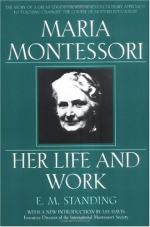
|
| Name: _________________________ | Period: ___________________ |
This test consists of 5 multiple choice questions, 5 short answer questions, and 10 short essay questions.
Multiple Choice Questions
1. What are the material called that were used in Froebel's classrooms?
(a) Froebelian documents.
(b) Froebelian tools.
(c) Froebelian gifts.
(d) Froebelian materials.
2. According to Montessori, what may happen if necessary supplies are not available in the classroom?
(a) Children will be dissappointed.
(b) Energy is wasted.
(c) Learning continues.
(d) Children will find another activity.
3. What is one example of an unusual task a visitor may see a Montessori child engaged in?
(a) Sweeping the floor.
(b) Sleeping.
(c) Writing.
(d) Reading.
4. According to Montessori, what prompts a child to learn to speak?
(a) Imitation.
(b) Other children speaking.
(c) Forced by adults.
(d) Inner impulse.
5. How does Standing state Froebelians view the Montessori method?
(a) Too unstructured.
(b) Perfect.
(c) Too vague.
(d) Too rigid.
Short Answer Questions
1. In "The Fundamental Problem & Prepared Environment," what type of food, does Standing state a child might prefer over a $500 ornate lunch?
2. According to Montessori, what must a a teacher do in order to no longer look at herself as someone with a duty to push children forward?
3. What type of interaction occurs in the Montessori classroom?
4. According to Standing, what is the highest form of spontaneous self-activity according to Froedlians?
5. Why is the physical environment important in the classroom?
Short Essay Questions
1. What is the significance of the physical aspects of the Montessori classroom?
2. What is the different between the teaching in a Froebel school compared to a teacher in a Montessori school?
3. According to Montessori, how can the struggle between the adult and the child end?
4. According to Standing, what are the two classifications of practical life exercises?
5. When did Montessori disagree with Froebels use of free play and make believe?
6. How does freedom in the Montessori classroom also come with laws to follow?
7. What does Standing mean by the term Inner Command?
8. According to "Liberty in Education & the Montessori Directress," how is it possible to be independent but not free?
9. What are the two distinct stages of learning in a Montessori classroom?
10. Why does the Montessori method keep a young child in a limited circle within the prepared environment?
|
This section contains 882 words (approx. 3 pages at 300 words per page) |

|




